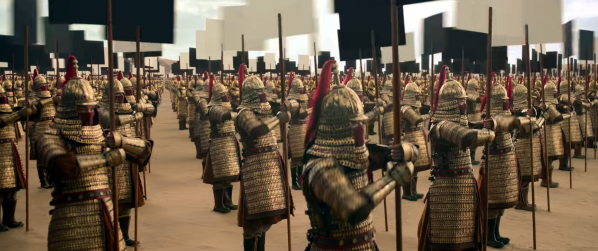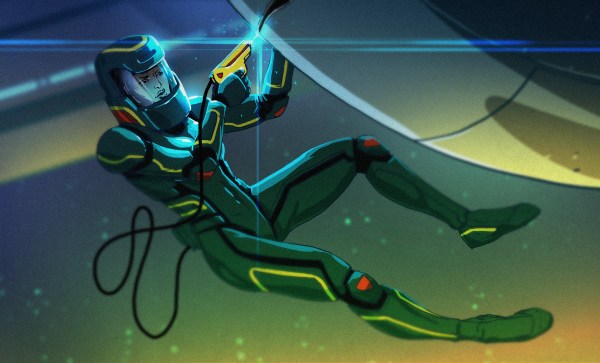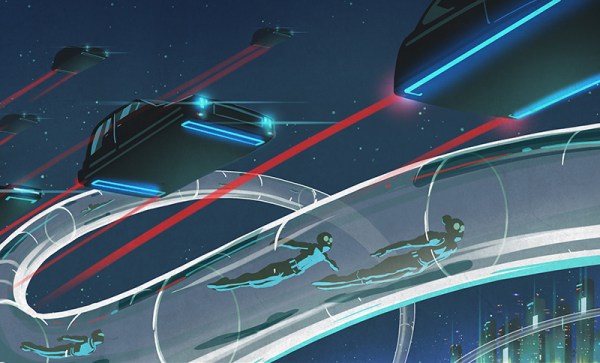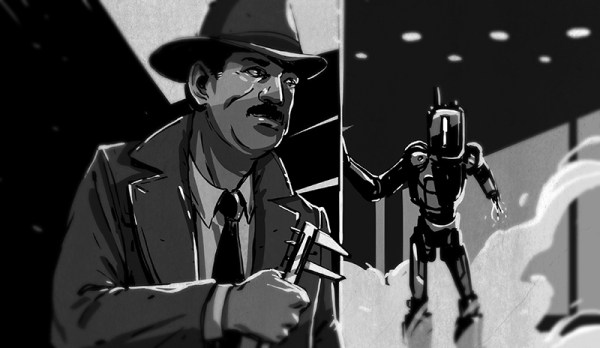It’s amazing how fragile our digital lives can be, and how quickly they can fall to pieces. Case in point: the digital dilemma that Paris Buttfield-Addison found himself in last week, which denied him access to 20 years of photographs, messages, documents, and general access to the Apple ecosystem. According to Paris, the whole thing started when he tried to redeem a $500 Apple gift card in exchange for 6 TB of iCloud storage. The gift card purchase didn’t go through, and shortly thereafter, the account was locked, effectively bricking his $30,000 collection of iGadgets and rendering his massive trove of iCloud data inaccessible. Decades of loyalty to the Apple ecosystem, gone in a heartbeat.
fiction7 Articles
Fictional Computers: The Three Body Problem
If you intend to see the Netflix series “The Three Body Problem” or you want to read the Hugo-winning story from Chinese author [Cixin Liu], then you should probably bookmark this post and stop reading immediately. There will be some mild spoilers. You have been warned.
While the show does have some moments that will make your science brain cringe, there is one scene that shows a computer that could actually be built. Would it be practical? Probably not in real life, but in the context provided by the show, it was perfectly feasible. It could have, however, been done a little better, but the idea was — like many great ideas — both deceptively simple and amazingly profound. The computer was made of human beings. I’m not talking like Dune’s mentats — humans with super brains augmented by drugs or technology. This is something very different.
Background
This is your last chance. There are spoilers ahead, although I’ll try to leave out as much as I can. In the story, top scientists receive a mysterious headset that allows them to experience totally immersive holodeck-style virtual reality. When they put the headset on, they are in what appears to be a game. The game puts you in a historical location — the court of Henry VIII or Ghengis Kahn. However, this Earth has three suns. The planet is sometimes in a nicely habitable zone and sometimes is not. The periods when the planet is uninhabitable might have everything bursting into flames or freezing, or there might not be sufficient gravity to hold them on the planet’s surface. (Although I’ll admit, I found that one hard to grasp.)
Apparently, the inhabitants of this quasi-Earth can hibernate through the “chaotic eras” and wait for the next “stable era” that lasts a long time. The problem, as you probably know, is that there is no general closed-form solution for the three-body problem. Of course, there are approximations and special cases, but it isn’t easy to make long-term predictions about the state of three bodies, even with modern computers.
Continue reading “Fictional Computers: The Three Body Problem”
Books You Should Read: The Bridge
A few weeks ago, Amazon’s crack marketing AI decided to recommend a few books for me. That AI must be getting better because instead of the latest special-edition Twilight books, I was greeted with this:
“The asteroid was called the Hand of God when it hit.”
That’s the first sentence of The Bridge, a new Sci-Fi book by Leonard Petracci. If you think that line sucks you in, wait until you read the whole first chapter.
The Bridge is solidly in the generation ship trope. A voyage hundreds or even thousands of years long, with no sleep or stasis pods. The original crew knows they have no hope of seeing their destination, nor will their children and grandchildren. Heinlein delved into it with Orphans of the Sky. Even Robert Goddard himself discussed generation ships in The Last Migration.
I wouldn’t call The Bridge hard Sci-Fi — and that’s perfectly fine. Leonard isn’t going for scientific accuracy. It’s a great character driven story. If you enjoyed a book like Ready Player One, you’ll probably enjoy this.
The Bridge Is the story of Dandelion 14, a ship carrying people of Earth to a new planet. At some point during the journey, Dandelion 14 was struck by an asteroid, which split the ship in two. Only a few wires and cables keep the halves of the ship together. The crew on both sides of the ship survived, but they had no way to communicate. They do catch glimpses of each other in the windows though.
Much of the story is told in the first person by Horatius, a young man born hundreds of years after the asteroid strike. Horatius’ side of the ship has a population of one thousand, carefully measured at each census. They’ve lost knowledge of how to operate the ship’s systems, but they are surviving. Most of the population are gardeners, but there are doctors, cooks, porters, and a few historians. At four years old, Horatius is selected to become a gardener, like his father was before him. But Horatius has higher aspirations. He longs to become a historian to learn the secrets of the generations that came before him and to write his own story down for those who will come after.
Horatius sees the faces of the people on the other side of the ship as well. Gaunt, hungry, often fighting with knives or other weapons. A stark contrast to the well-fed people on his side of the vessel. The exception is one red-haired girl about his age. He often finds her staring back at him, watching him.
Horatius might have been chosen as a gardener, but he’s clever — a fact that sometimes gets him in trouble. His life takes an abrupt turn when the sleeping ship awakens with an announcement blaring “Systems Rebooting, Ship damage assessed. Reuniting the two halves of the ship and restoring airlock, approximately twenty-four hours until complete.”
The hardest part of writing a book review is not giving too much away. While I won’t tell you much more about the plot for The Bridge, I can tell a bit about how the book came about. You might call this book a hack of the publishing system. Leonard Petracci is also known as leoduhvinci on Reddit. The Bridge started life as Leonard’s response to a post on /r/writingprompts. The prompt went like this:
After almost 1,000 years the population of a generation ship has lost the ability to understand most technology and now lives at a pre-industrial level. Today the ship reaches its destination and the automated systems come back online.
Leonard ’s response to the prompt shot straight to the top, and became the first chapter of The Bridge. Chapter 2 followed soon after. In only a few months, the book was complete. Available on Reddit, and on Leonard’s website. The Bridge is also available on Amazon for Kindle, and on paper from Amazon’s CreateSpace.
The only real criticism I have about The Bridge is the ending. The book’s resolution felt a bit rushed. It would have been nice to have a few more pages telling us what happened to the characters after the major events of the book. Leonard is planning a sequel though, and he teases this in the final pages.
You can start reading The Bridge right now on Leonard’s website. He has the entire book online for free for a few more weeks. If you’ve missed the free period, the Kindle edition is currently $2.99.
Fictional Hacking: Michael Westen
I don’t know if it is true or not today, but in fiction, spies depend on lots of high-tech gadgets. I do know that during World War II, the various secret services like the OSS and the SOE did have gadgets like secret transmitters and concealed weapons. But, like [James Bond’s] grenade-launching ink pen, to [Maxwell Smart’s] shoe phone, those gadgets came from some organized lab. (When you watch the video below, remember that at that time, a personal phone going off in a theater was unknown as cell phones were years in the future.)
Engage Tinfoil Hat: Samsung Note 7 Battery Theory
For the most part I believe things are as they seem. But every once in a while I begin to look at notable technology happenings from a different angle. What if things are not like they seem? This is conspiracy theory territory, and I want to be very clear about this: what follows is completely fictitious and not based on fact. At least, I haven’t tried to base it on facts surrounding the current events. But perhaps you can. What if there’s more to the battery fires in Samsung’s Galaxy Note 7 phones?
I have a plausible theory, won’t you don your tinfoil hat and follow me down this rabbit hole?
Continue reading “Engage Tinfoil Hat: Samsung Note 7 Battery Theory”
Hyperloops And Robot Cars, A Glimpse Into The Future
His mobile blooped at him with one of those noises a company spent money to get. A timer started on the screen as he rushed to put his shoes on. He finished and pushed open his door, running down the stairs two to a bound. By the time he reached the bottom of the stairs he had his backpack slung over both shoulders, which he mentally cursed himself for since he’d just have to take the dang thing off again.
It was morning on January first, and he was due at his parent’s house for a new year’s dinner fifteen hundred miles away. He should have booked a plane weeks ago, but now the Loop was his only option. The Loop didn’t really have peak rates, and while the plane would be a little faster, more direct, and cheaper IF he had remembered to book it in time, the Loop would take him the same distance today. Plus, the seats were comfier. They reclined nicely, and he intended to nap on the way. Hopefully, by the time he got there, the bleariness from last night’s celebration would be undetectable by parental senses.
He locked the door to his apartment complex, a reassuringly square assembly from the seventies, and walked to the sidewalk where a friendly light blue car waited for him. When he got close, his mobile vibrated and made another distressingly cheery noise. The doors of the car swung open opposite of each other to expose the space inside. The car displayed two rows of inward facing bench seats, a panoramic row of windows around the entire perimeter of the vehicle, and… yes, his nose was telling him before his eyes fixed on it, a very unsettling amount of vomit in the center of the floor.
He turned around, a bit squeamish, and took out his mobile. He navigated through the controls. Where is the menu option? What year is it now? Why is this still hard? Three awkward menus deep and he finally found and selected the option to let the dispatch know the car had an issue which made it uninhabitable. The car immediately began to chirp warnings and the doors soon started to close. In a moment, a human somewhere in the city would be looking at a video of the inside of the car, determining him a liar or not. As expected, a few seconds later, the little car began to drive off. The lights on the rear of the car turned from bright red to the yellow amber of headlights as it decided its front would be its back. It drove off to the dispatch center for cleaning and repair. Someone would be eating a 100 dollar cleaning bill today. He didn’t feel sorry for them.
His phone began to vibrate. He picked it up to answer a call from a bored customer service representative who was trying hard to sound earnest. “Sorry for the trouble sir, the ride today will be free. We have another car on its way”
Continue reading “Hyperloops And Robot Cars, A Glimpse Into The Future”
Dr Noirimetla, Private Failure Investigator And The Mystery Of Galileo’s Pillars
One dark and stormy morning, Dr. Richard Noirimetla, private failure investigator, was sitting at his desk nursing his morning cup of joe. It was an addiction, but life, and engineering was hard. Intense eyes sat in a round dark-skinned face. An engineering degree from the prestigious Indian Institute of Technology hung from the wall in his sparse office. Lightning flashed outside of his window, as the rain began to beat even harder against his corner office windows.
His phone rang.
“Hello, Dr. Noirimetla, Private Failure Investigator here.” He said in deep, polite voice. “How may I help you?”
“Ah, I’m Chief of Manufacturing for Galileo Concrete Pillars Inc. We have a bit of a problem here. We used to see a failure rate above 33% for our concrete pillar operation. As part of our lean manufacturing efforts we tried to reduce that number through various improvements. However, we see a failure rate of almost 50% now. We expect foul play… from one of our suppliers. Can you come right away?” a worried man’s voice sounded over the phone.
“I see, that’s very troubling,” Noirimetla rumbled. “I’ll send over the contract detail. There will be an increased fee, but I’m on my way.”
“Sounds good, we’ll pay anything! Just get our operation up to standards!” The man bid a polite goodbye and hung up.
Continue reading “Dr Noirimetla, Private Failure Investigator And The Mystery Of Galileo’s Pillars”

















